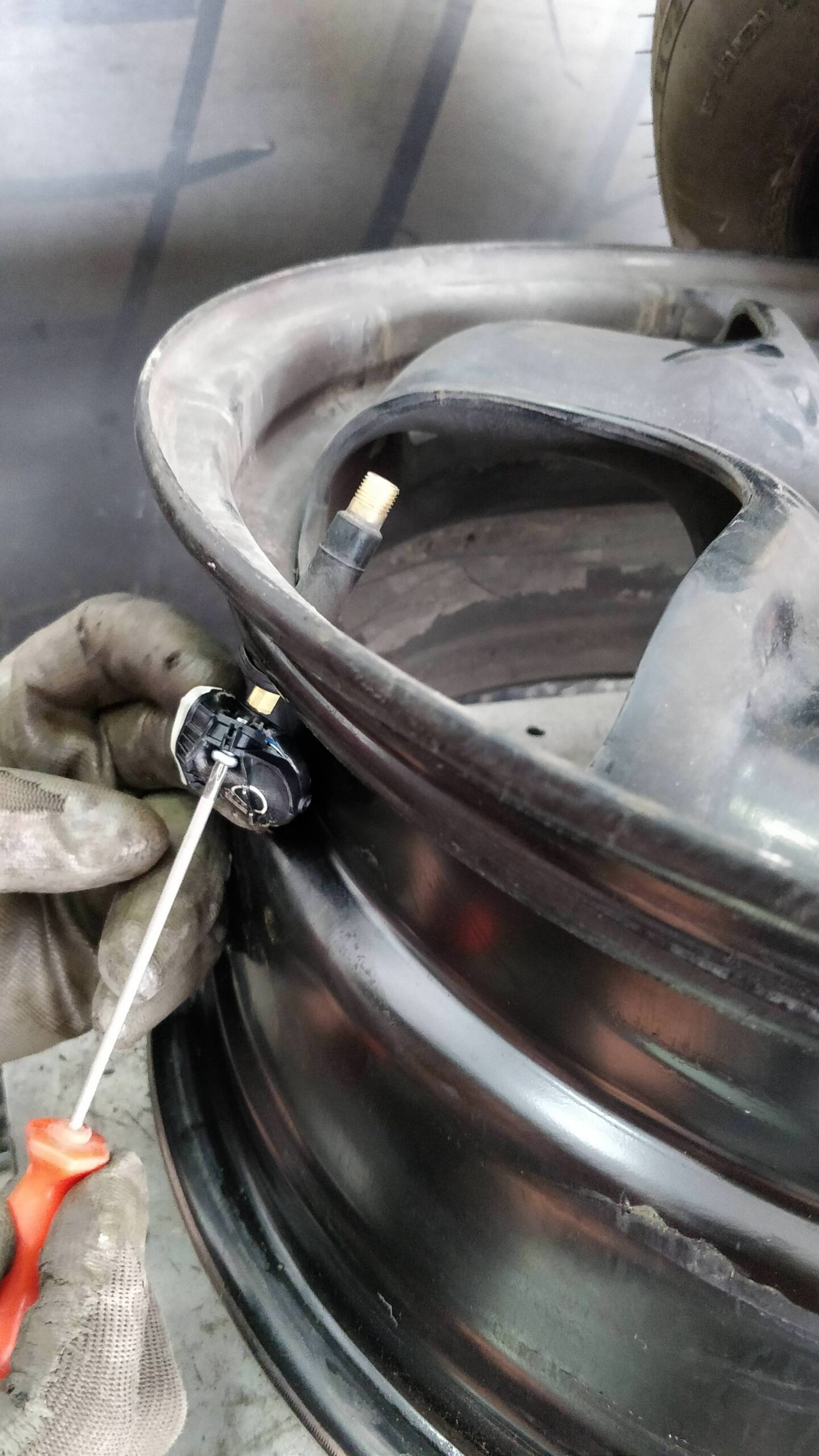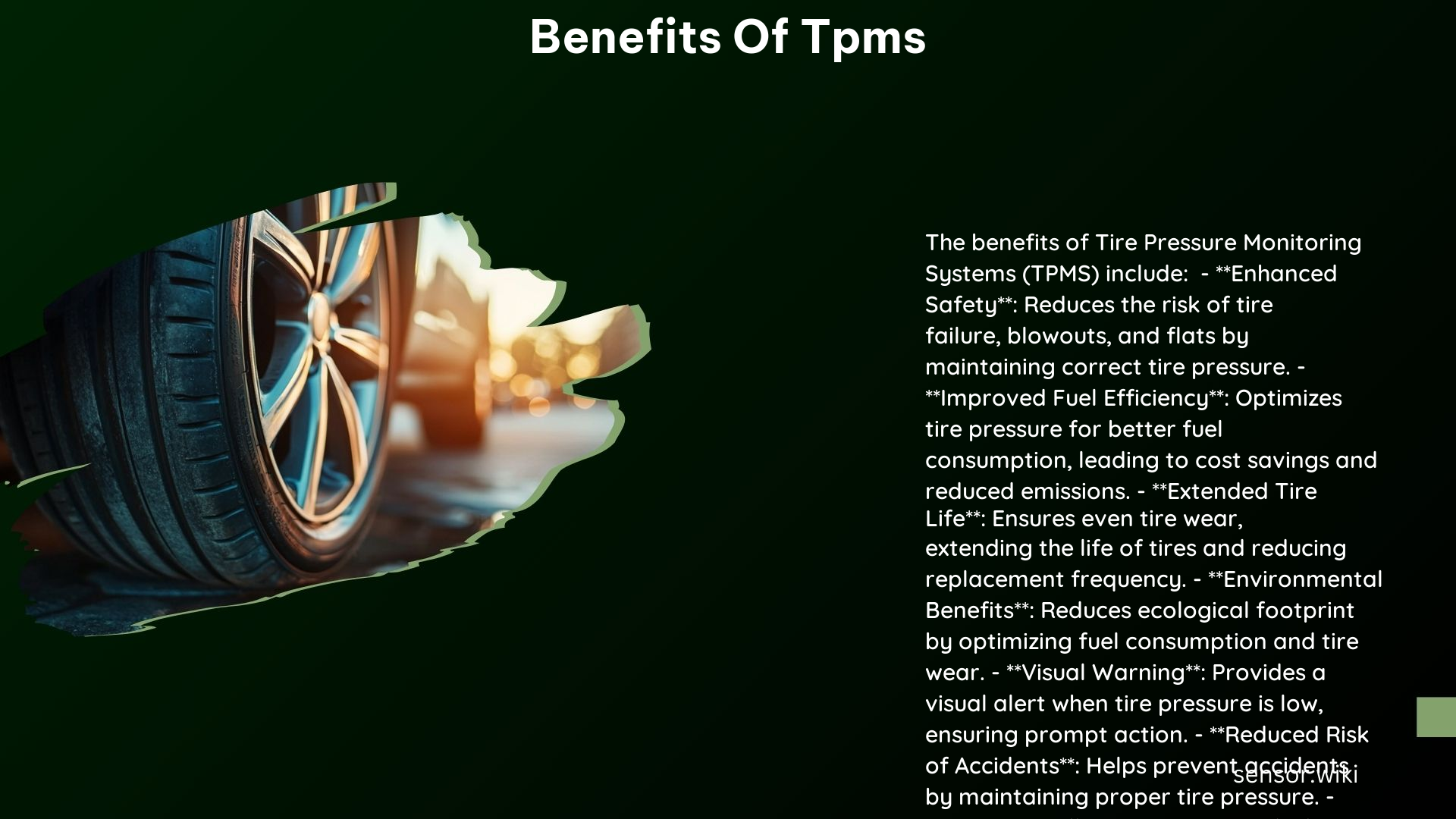Tire Pressure Monitoring Systems (TPMS) are an essential safety feature in modern vehicles, providing real-time information about the air pressure in each tire. By continuously monitoring tire pressure, TPMS offers a range of benefits that enhance driving safety, efficiency, and overall vehicle performance. In this comprehensive guide, we’ll delve into the technical details and quantifiable advantages of TPMS, empowering you with the knowledge to make informed decisions about your vehicle’s maintenance and safety.
Enhanced Safety

One of the primary benefits of TPMS is its ability to enhance driving safety. By alerting drivers to low tire pressure, TPMS reduces the risk of tire failure, blowouts, and flats. According to the National Highway Traffic Safety Administration (NHTSA), underinflated tires are a contributing factor in over 600 fatalities and 33,000 injuries each year in the United States alone.
TPMS systems use sensors installed in each wheel to constantly monitor the air pressure in the tires. When the pressure in any tire drops below a predetermined threshold, typically 25% below the recommended level, the TPMS warning light on the dashboard illuminates, alerting the driver to the issue. This early warning allows drivers to address the problem before it escalates, potentially preventing a dangerous situation.
Moreover, TPMS improves vehicle handling and braking performance. Properly inflated tires offer optimal traction and responsiveness, which is crucial for maintaining control of the vehicle, especially in emergency situations. A study by the NHTSA found that vehicles equipped with TPMS had a 30% lower risk of being involved in a crash due to tire-related issues compared to vehicles without TPMS.
Improved Fuel Efficiency

Properly inflated tires play a significant role in optimizing a vehicle’s fuel efficiency. Underinflated tires create more rolling resistance, which requires the engine to work harder and consume more fuel to maintain the same speed. According to the U.S. Department of Energy, every 1 psi drop in tire pressure can reduce fuel economy by up to 0.3%.
TPMS helps maintain optimal tire pressure, ensuring that the tires are operating at their most efficient level. By reducing rolling resistance, TPMS-equipped vehicles can achieve up to a 3% improvement in fuel economy, translating to substantial savings on fuel costs over the lifetime of the vehicle.
For example, a study by the NHTSA found that a vehicle with a 25% underinflated tire could see a 2.5% decrease in fuel economy. Assuming an average fuel cost of $3.50 per gallon and an annual mileage of 15,000 miles, the potential annual savings from using TPMS could be as much as $105 per vehicle.
Extended Tire Life
Maintaining optimal tire pressure is crucial for ensuring even tire wear and maximizing the lifespan of the tires. Underinflated tires tend to wear more quickly on the outer edges, while overinflated tires wear more rapidly in the center of the tread. This uneven wear can lead to premature tire replacement, which can be a significant expense for vehicle owners.
TPMS helps maintain the recommended tire pressure, which in turn promotes even tread wear and extends the overall life of the tires. According to a study by the Rubber Manufacturers Association, properly inflated tires can last up to 4,700 miles longer than underinflated tires.
Furthermore, TPMS can help identify potential issues with the tires, such as slow leaks or punctures, before they become more severe. By addressing these problems early, vehicle owners can avoid the need for costly tire replacements and extend the usable life of their tires.
Environmental Benefits
The benefits of TPMS extend beyond the individual vehicle owner, as they also contribute to environmental sustainability. By optimizing fuel consumption and reducing tire wear, TPMS helps lower the overall carbon footprint of vehicle operation.
Improved fuel efficiency, as mentioned earlier, directly translates to reduced greenhouse gas emissions. According to the U.S. Environmental Protection Agency (EPA), every gallon of gasoline burned produces approximately 8.8 kilograms of carbon dioxide (CO2). By improving fuel economy, TPMS-equipped vehicles can reduce their CO2 emissions by up to 3% compared to vehicles without TPMS.
Additionally, the extended tire life facilitated by TPMS reduces the demand for new tire production and the associated environmental impact. Tire manufacturing is a resource-intensive process that consumes significant amounts of energy, water, and raw materials, as well as generating waste and emissions. By extending the lifespan of tires, TPMS helps mitigate the environmental burden of tire production and disposal.
Convenience and Reduced Maintenance
TPMS provides a convenient solution for monitoring tire pressure, eliminating the need for manual checks and guesswork. The real-time tire pressure information displayed on the vehicle’s dashboard or infotainment system allows drivers to quickly identify and address any issues, making it easier to maintain proper tire inflation.
Furthermore, TPMS reduces the frequency of manual tire pressure checks, saving vehicle owners time and effort. According to a study by the NHTSA, vehicles equipped with TPMS require 30% fewer tire pressure checks compared to vehicles without the system.
This reduction in maintenance requirements translates to cost savings for vehicle owners, as they can avoid the time and labor associated with regular manual tire pressure checks. Additionally, the early detection of tire pressure issues can help prevent more costly repairs or replacements down the line, further contributing to the overall cost savings.
Compliance with Regulations
In many countries, including the United States, the European Union, and the United Kingdom, TPMS has become a mandatory safety feature for new vehicles. This regulatory requirement ensures that all vehicles are equipped with a system that can detect and alert drivers to low tire pressure, enhancing overall road safety.
For example, in the United States, the TPMS mandate was introduced in 2007, requiring all new passenger vehicles to be equipped with the system. Similarly, the European Union has required TPMS in all new passenger cars and light commercial vehicles since 2014.
By complying with these regulations, vehicle owners can be confident that their vehicles are equipped with the necessary safety features to protect themselves and other road users. Additionally, the widespread adoption of TPMS helps to standardize the technology and drive further advancements in tire pressure monitoring systems.
In conclusion, Tire Pressure Monitoring Systems (TPMS) offer a comprehensive set of benefits that enhance driving safety, efficiency, and environmental sustainability. From reducing the risk of tire-related accidents to improving fuel economy and extending tire life, TPMS provides a valuable solution for vehicle owners. By understanding the technical details and quantifiable advantages of TPMS, you can make informed decisions about your vehicle’s maintenance and safety, ultimately contributing to a safer and more sustainable transportation ecosystem.
References:
– National Highway Traffic Safety Administration (NHTSA) – https://www.nhtsa.gov/equipment/tires
– U.S. Department of Energy – https://www.fueleconomy.gov/feg/maintain.jsp
– Rubber Manufacturers Association – https://www.rma.org/
– U.S. Environmental Protection Agency (EPA) – https://www.epa.gov/greenvehicles/greenhouse-gas-emissions-typical-passenger-vehicle
– Goodyear – https://www.goodyear.eu/en_gb/consumer/learn/what-is-tpms.html
– Bridgestone – https://www.bridgestonetire.com/learn/maintenance/tire-pressure-monitoring-system-how-tpms-works/
– Tires Plus – https://www.tiresplus.com/tires/tire-buying-guide/tpms/
– Burt Brothers – https://burtbrothers.com/tips/benefits-of-tire-pressure-monitoring-systems/
– Tech Tire Repairs – https://techtirerepairs.com/tire-pressure-monitoring-systems-tpms-explained-benefits-and-maintenance/
